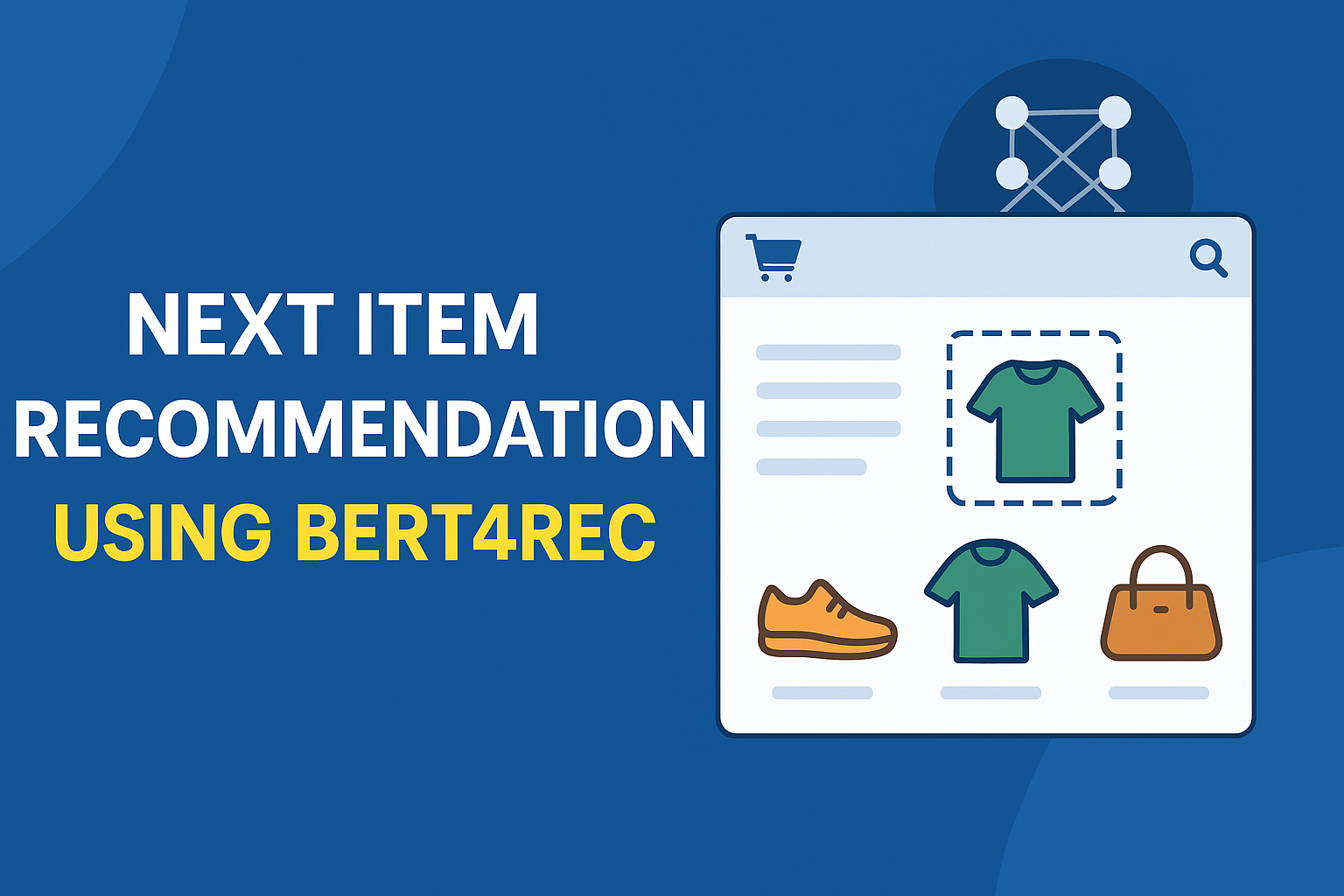
Next Item Recommender Using BERT4Rec
ML Model Design, Training, Deployment
Confidential
End 2024 - Early 2025
Next Item Recommendation Using BERT4Rec
A large e-commerce client operating in fashion, electronics, and lifestyle segments wanted to improve the accuracy and relevance of their recommendation engine. Historically, they were using standard collaborative filtering methods, but they faced limitations with scalability, cold-start problems, and the inability to understand sequential patterns in user behavior.
The objective of this project was to build a Next Item Recommendation System that can predict the most probable next purchase a user might make. We resorted to using sequential modelling for the problem and used BERT4Rec, a state-of-the-art sequential recommendation algorithm based on Transformer architecture.
Project Challenges
1. Data Sparsity and Sequence Noise
-
User behavior data was sparse for long-tail products.
-
Many users had short interaction histories, while others had extremely noisy sequences (browsing behavior that does not always reflect purchase intent).
-
Normalizing and cleaning the data to ensure sequence quality was non-trivial.
2. Scalability
-
The dataset comprised over 10 million users and 2 million products.
-
Traditional recommendation models struggled with such scale, especially when capturing sequential dependencies.
3. Cold Start and Long-Tail Problem
-
New products and new users frequently entered the ecosystem.
-
Collaborative filtering suffered from cold-start issues, whereas BERT4Rec needed fine-tuning to make effective predictions even with fewer interactions.
4. Latency Requirements
-
The client required recommendations to be delivered in real time (<100 ms).
-
Serving a deep learning model like BERT4Rec efficiently in production, at this latency, required careful system design.
Model Training Setup
1. Data Pipeline
Collected user-item interaction logs: views, add-to-carts, purchases.
Events were chronologically ordered and tokenized (similar to words in NLP tasks).
Each item was represented as a unique token.
Included contextual embeddings for time of day, device type, and user segments.
2. Model Architecture
We used BERT4Rec, which adopts the bidirectional transformer architecture from BERT.
Sequence of user interactions is treated like a sentence, and the model is trained to predict masked items (like masked language modeling).
Hyperparameters:
Hidden size: 256
Number of transformer layers: 4
Number of attention heads: 8
Max sequence length: 50 (based on analysis of typical user session length)
3. Training Strategy
Masked Item Prediction: Randomly mask a percentage of items in the sequence and train the model to predict them.
Negative Sampling: For every positive interaction, sample multiple negative items to improve learning.
Learning rate scheduling: Used warm-up with cosine annealing.
Training infrastructure:
Distributed training on a multi-GPU setup using NVIDIA A100 GPUs.
Mixed precision training for speed-up.
Training time: ~20 hours for convergence.
4. Evaluation Metrics
Hit Rate@K
NDCG@K
Mean Reciprocal Rank (MRR)
Offline evaluation showed improvements of:
+25% Hit Rate@10 over baseline
+18% NDCG@10 over collaborative filtering baseline
Model Deployment Setup
1. Model Serving Architecture
Model was exported to ONNX format for optimized inference.
Used TensorRT for GPU-based serving with low latency.
Model hosted on Kubernetes cluster with horizontal scaling based on traffic load.
2. Feature Store Integration
FEAST was used as a feature store for the user interaction fetaures
At inference time, the latest user sequence was pulled from the feature store to feed into the model.
3. Real-time API
RESTful API with latency under 70 ms per request.
Caching layer for frequent queries.
Fallback strategy to default recommendations in case of system failure.
4. Monitoring and Retraining
Integrated with monitoring tools (Prometheus + Grafana) for real-time performance tracking.
Retraining scheduled weekly to keep up with new trends and products.
Automated alerts for model drift or performance degradation
Business Metrics
1. Higher Conversion Rates
Personalized, Context aware recommendations lead to +15% uplift in conversion rates
Better prediction of next likely purchase, especially in multi-category sessions.
2. Reduced Bounce Rates
More engaging recommendations increased session times and reduced bounce rates by ~12%
3. Enhanced User Experience
Real-time, accurate recommendations improved customer satisfaction.
Seamless cross-device recommendation consistency due to centralized sequence tracking.
4. Operational Efficiency
Automated retraining and scalable architecture reduced operational overhead.
Model updates are faster, enabling the business to react quickly to seasonal trends and campaigns.
5. Future Scalability
The Transformer-based architecture is flexible for future enhancements like:
Multi-modal inputs (images, text descriptions)
Multi-task learning (cross-sell and upsell predictions)
Conclusion
Switching from collaborative filtering to BERT4Rec-based sequential recommendation significantly advanced the client’s recommendation capabilities. Not only did it improve key business metrics, but it also provided a future-proof, scalable solution aligned with their growth ambitions.
The success of this project underscores the value of leveraging advanced deep learning architectures for real-time, personalized recommendations in large-scale e-commerce environments.

